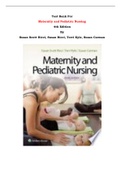Exam (elaborations)
Disorders of Childhood: Development and Psychopathology 3rd Edition By Robin Hornik Parritz; Michael F. Troy 9781337098113 Chapter 1-14 Complete Guide .
- Module
- Institution
- Book
Disorders of Childhood: Development and Psychopathology 3rd Edition By Robin Hornik Parritz; Michael F. Troy 9781337098113 Chapter 1-14 Complete Guide .
[Show more]













